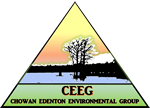Below is an except from a recent piece on CEEG in the Albemarle-Pamlico National Estuary Partnership. Read the entire piece here.
The communities along the Chowan River and Albemarle Sound in northeastern North Carolina have a centuries-old connection to the region’s many waterways. In fact, Edenton, a small town at the confluence of the Chowan and Roanoke Rivers, was one of North Carolina’s first colonial capitols from 1722 to 1743 and the area has been home to present day and ancestral American Indian communities. “People whose families have been here for hundreds of years have made their livelihood off these waterways,” explains Colleen Karl, Chair of the Chowan-Edenton Environmental Group. “They’ve fished, they’ve used that water for agriculture and for a lot of different reasons. The water is part of their history and culture; it’s all bound together.”

Colleen and the Chowan-Edenton Environmental Group, or CEEG, want to ensure future generations have the same opportunity to forge a connection to the water. The CEEG, a citizen group organized around 2007 to tackle environmental issues in and around Edenton, has more recently become a nexus for efforts to monitor water quality in the area. This includes using the power of citizen science to investigate the puzzling return of seasonal algal blooms to the Chowan River and Albemarle Sound.
